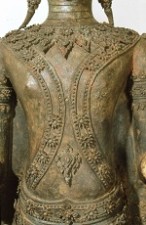
Unknown
Thai
Adorned Buddha, 17th - 18th c. CE, Ayuthya period
bronze
37 1/2 × 10 1/2 × 4 3/4 in.
SBMA, Gift of Mrs. Ina T. Campbell
1946.2
RESEARCH PAPER
CONTENT AND PERIOD
This is an extremely decorative bronze Bodhisattva statue. The entire statue appears to be encrusted with jewels and ornamentation. Usually such fine and worldly garments would indicate a Bodhisattva rather than a Buddha. Buddha is usually depicted in simple monastic robes. There is one exception to this rule and that is the “Adorned Buddha.” In the 16th century in Thailand the jeweled type of Buddha did come into fashion.
This statue is not truly three-dimensional or “in the round.” There is a certain degree of flatness, particularly in the back of the sculpture. This is possibly due to the use of the statue, perhaps against a temple wall. This Buddha or Bodhisattva has a circular hole in the top of its “ushnisha.” Perhaps, an extension of the top know is missing. A flame emblem was a very popular finial used tor the ushnisha in Thailand. It was called a “ketumala.” There is also the possibility that this opening in the top knot is where the molten bronze was poured in.
There seems to be a certain amount of Hindu influence in this statue. It must be remembered that at this time in Thailand the two religions, Hinduism and Buddhism, were in peaceful co-existence (see fig. 205 in Le May).
The expression of the face of this statue is beatific. The eyes are not truly almond shaped as in the Bayon style of the Khmer period, nor is the mouth as large or thick-lipped as most Khmer sculpture. The arms appear to be in the “Abhaya Mudra” position — Buddha’s gesture of reassurance or blessing. The ears are very elongated and adorned with dangling earrings, symbolizing Buddha’s renunciation of riches. There is no delineation of the legs in this statue. A long robe covers both legs giving a solid and rather stiff effect. This usually gave greater stability to the statue and also made it easier to cast. It is difficult to tell if originally this statue had feet.
MEDIA AND TECHNIQUE
With both hands broken off exposing the interior, this statue provides an excellent example of the lost wax method or the “Cire-Perdue.” Basically the sculptor formed an object in the wax and then packed soft clay around it. When the clay hardened, he put the wax object, encased in the clay, into a fire and watched the wax melt and run out of the clay, leaving a mold or negative of his original model. Then by pouring molten metal into the hole in the clay that had been formed when the wax ran out, the sculptor achieved his lost wax bronze. In order to conserve bronze the artist would sometimes begin with a baked clay core and on this mold his wax. He would then continue with the processes described above. Our artist appears to have done this as indicated by the clay exposed in the broken arms and the clay exposed on the right thigh. Bronze was the favorite medium of the Thai artists at this time.
STYLE
In all the examples of Thai sculpture found in the books consulted there is no Thai statue that closely resembles our sculpture. The statues most similar to ours are Thai statues of Vishnu and Siva. These were early 15th century. Our statue could come from a decadent style of art, a style that was not strong enough or artistic enough to be perpetuated by other artists. There is definitely some Khmer influence present in this statue, but one can not help but feel that this sculpture is a poor imitation at its best. This statue seems to be definitely Thai in origin although one would question the date. Around the middle of the 15th century the U-T’ong style began to merge into the Ayudhya or National Style. The National Style lasted for more than 300 years. Along with Bayon influence there is evidence of Ayudhya influence in our sculpture (as shown in Figs. 199, 200, and 205 in Le May).
CONCLUSIONS
There is a possibility that this is not a 15th century bronze Thai Bodhisattva. It seems more likely that it is an early 16th [to 18th] century Thai ADORNED BUDDHA.
Prepared for the Santa Barbara Museum of Art Docent Council by Joyce Donald
BIBLIOGRAPHY
Eliscu, Frank. “Direct Wax Sculpture.” Chilton, 1959.
Griswod, A. B. “The Arts of Thailand.” Indiana, 1960.
Groslier, Bernard Phillippe. “The Art of Indochina.” New York, 1962.
Hoffman, Malvina. “Sculpture Inside and Out.” Norton, 1939.
Le May, Reginald. “A Concise History of Buddhist Art in Siam.” Vermond, 1962.

SBMA CURATORIAL LABELS
Lavishly decorated with jewels, this Buddha became popular in Thailand during the 16th century. This figure emphasized the concept of Buddha as the Universal King and symbolically referenced the secular kings who patronized Buddhism. In Southeast Asia, Theravada ("Word of the Elders") Buddhism became the dominant religion, based on the exemplary life of the historical Buddha Shakyamuni. Most Buddhist images in the region depict the historical Buddha, rather than the vast pantheon of buddhas, bodhisattvas and deities in Mahayana and Vajrayana Buddhist texts from other Asian cultures.
- India, Southeast Asia, and Himalayas, 2022
